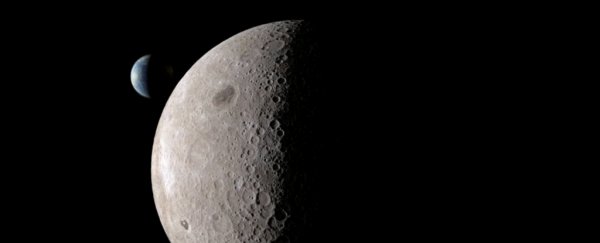Nobody has ever put a lander on the far side of the Moon before, but China is well on its way to being the first. Over the weekend, the country launched a craft called Queqiao - a satellite that will orbit the Moon to relay messages from the yet-to-be-launched lander, Chang'e-4.
The Moon is tidally locked with Earth - it takes the same amount of time to perform one full rotation on its axis as it does to orbit once around Earth. Hence, one side of our satellite is permanently facing away from us.
We have seen the far side of the Moon, thanks to probes, orbiters, and Apollo missions, but the only human-made object to go there was Ranger 4, an impactor probe designed to transmit images before it crashed into the lunar surface. It malfunctioned, and no scientific data was returned.
One of the major hurdles is the fact that, once a lander is on the far side of the Moon, the Moon itself will shield against any radio signals sent back to Earth. So a solution needed to be found - and that's where Queqiao comes in.
The name translates to "Magpie Bridge," a reference to a folktale called The Cowherd and the Weaver Girl. Their love is forbidden, so they are banished to opposite sides of the sky; but, once a year, magpies form a bridge so the two can meet.
Queqiao will act as the communication bridge between Chang'e-4, due to be launched later this year, and Earth. It will sit in what is known as a Lagrange point - the spot where the combined gravitational forces of two larger bodies (in this case Earth and the Sun) create a small area of gravitational stability.
 Lagrange points. (Anynobody/Wikimedia Commons)
Lagrange points. (Anynobody/Wikimedia Commons)
Each pair of larger bodies has five of these Lagrange points. Queqiao will sit in L2, directly in line with the two bodies and about 65,000 kilometres (40,390 miles) from the Moon, where it will move with both of them.
From that vantage point, it will be able to bounce radio signals transmitted by Chang'e-4 back to Earth - and in the other direction, too, so Earth-based scientists can control the robotic lander.
But Queqiao won't be just twiddling its thumbs waiting for Chang'e-4. The satellite also carried with it the first radio antenna to be installed on the far side of the Moon, designed by the Netherlands Institute for Radio Astronomy (ASTRON).
It's called the Netherlands Chinese Low-Frequency Explorer (NCLE), and it may help us receive radio frequencies going all the way back to the Big Bang - some of the only frequencies that can't reach us on Earth.
"Radio astronomers study the Universe using radio waves, light coming from stars and planets, for example, which are not visible with the naked eye. We can receive almost all celestial radio wave frequencies here on Earth," explained astrophysicist Heino Falcke of ASTRON.
"We cannot detect radio waves below 30 MHz, however, as these are blocked by our atmosphere. It is these frequencies in particular that contain information about the early Universe, which is why we want to measure them."
Queqiao also carried into space two microsatellites, which will orbit the Moon independently on an ellipse, Longjiang 1 and Longjiang 2. These will also perform radio observations, with amateur scientists able to download telemetry and data to perform their own analyses.
Chang'e-4 will carry an entirely different scientific payload: seeds of potatoes and arabidopsis flowers, as well as silkworm cocoons. These will be kept in a mini biosphere, and observed to see if they can grow - and maybe even flourish - on the Moon.
Queqiao will enter its position in L2 sometime in June, and Chang'e-4 will launch later this year.
